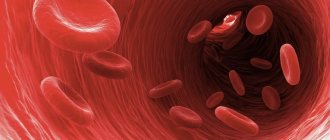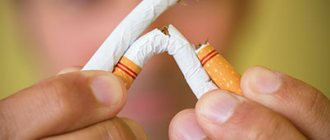Nicotine molecules bind to acetylcholine receptors, temporarily increasing their activity. This explains the feeling of mild euphoria, increased performance and a surge of energy after smoking a cigarette. But after half an hour the activity of the receptors drops. A person begins to feel the need for an additional dose of nicotine, since there are no natural substitutes for this substance in the body. If you do not smoke again, nervousness and anxiety appear.
Content:
- Circulatory problems caused by smoking
- How does the body react to the intake of tobacco smoke?
- How does nicotine affect blood vessels?
- Features of blood circulation in the brain during smoking
- Nicotine and blood vessels of the lower extremities
- How to prevent the effects of nicotine on blood vessels
Tobacco smoking has a particularly pronounced effect on the cardiovascular system. Some believe that the main ingredient contained in tobacco, nicotine, constricts blood vessels. Others think that it expands them, or does not affect vascular tone at all. What's really going on?
The effect of smoking on the human body
Smoking, undoubtedly, has a detrimental effect on all systems of the body, but a description of all the effects of smoking on the smoker’s body would result in a separate medical reference book. Therefore, we will consider only the most basic.
A cigarette is poison in its purest form. Contains about 4,000 chemical compounds, and tobacco smoke contains about 5,000, of which approximately 60 cause cancer.
Nicotine. We have heard since childhood that a drop of nicotine kills a horse. When smoking a cigarette, you can “consume” from 0.1 to 1.8 mg of nicotine and, according to the “horse” scheme, go to the cemetery after the first pack. In fact, nicotine is not a carcinogen. First of all, it is a psychoactive substance that is addictive.
When smoked, nicotine causes the arteries to narrow, thereby making it difficult for oxygen carried in the blood to reach the heart, brain, lower extremities and other organs. Moreover, nicotine acts quickly, constricting blood vessels within a minute after the first puff. The normal lumen of blood vessels is not restored soon. Therefore, a smoker often constantly keeps his blood vessels in a spasmodic state.
In addition, nicotine, entering the bloodstream, irritates the adrenal glands, which release the hormone adrenaline into the blood, which also constricts blood vessels and increases blood pressure. The constant flow of adrenaline into the blood causes persistent changes in the vascular walls.
The effects of nicotine are also characterized by decreased appetite, impaired stomach function, and a sharp decrease in the body’s saturation with vitamin C, which does not normalize even with the introduction of large doses of ascorbic acid.
Nicotine has a detrimental effect on sexual and reproductive functions, vision and hearing.
Carbon monoxide or carbon monoxide is a poisonous compound found in tobacco smoke.
Flowing through the smallest vessels of the lungs, the blood gives off carbon dioxide, which we exhale, and absorbs oxygen from the air, which is then distributed to all organs and tissues. Carbon monoxide in tobacco smoke has a hundreds of times greater affinity for hemoglobin than oxygen. Therefore, it displaces oxygen from its connection with hemoglobin, forming carboxyhemoglobin, and this interferes with the normal delivery of oxygen to the brain and other organs that need it. As a result, smokers develop chronic oxygen starvation, which affects the cardiovascular system and other organs and tissues.
Tobacco tar is a respiratory tract irritant and contributes to the development of chronic bronchitis, bronchial asthma, and emphysema. But the worst thing is that it is a strong carcinogen that can suppress antitumor immunity and damage the DNA of cells, leading them to a malignant state. Therefore, smoking often leads to cancer.
Dozens of different alcohols, aldehydes, ketones, and phenols contained in tobacco smoke have a harmful effect on the respiratory tract. Acrolein, formic and acetic acids, which have a strong irritating effect, and other substances cause inflammation of the mucous membranes lining the bronchial tree and the deeper layers of the bronchial wall.
This is not a complete list and characteristics of those poisons that are part of tobacco smoke.
Smoking causes the greatest harm to the cardiovascular, respiratory, and nervous systems, and, finally, is a factor that provokes the appearance of cancerous tumors.
Smoking and the cardiovascular system.
The delivery of oxygen to the heart muscle is sharply impaired due to the blocking of blood hemoglobin by carbon monoxide from tobacco smoke. This leads to serious damage to the heart and blood vessels.
Smoking increases blood pressure: blood vessels constrict, forcing the heart to work harder.
Smoking increases blood cholesterol levels. Fats accumulate in the arteries supplying the heart and become blocked. As a result, myocardial infarction. Smokers have a 4-5 times higher risk of myocardial infarction than non-smokers. If a smoker has high blood cholesterol and high blood pressure, the risk of developing a heart attack increases 8 times.
In people who smoke, cerebral stroke (acute cerebrovascular accident) is recorded 4-8 times more often than among non-smokers and former smokers.
Tobacco smoking is considered by doctors in all countries as the main cause of such a serious disease as obliterating endarteritis of the vessels of the lower extremities (obliteration - closure, endarteritis - inflammation of the inner lining of the artery). This disease occurs 9 times more often in smokers than in non-smokers.
Smoking and respiratory tract.
Tobacco smoking is a major risk factor for respiratory diseases: chronic bronchitis, chronic obstructive pulmonary disease, pneumonia, lung cancer.
Chronic bronchitis in smokers is registered 5-7 times more often than in non-smokers. Chronic bronchitis is manifested by a cough with sputum. In some patients, cough with sputum is the only symptom, while others have complaints of difficulty breathing or shortness of breath. The air we breathe must be purified before it reaches the lower part of the lungs. This function is performed by mucus, a sticky liquid found in the nose and upper respiratory tract. The mucus traps dirt and bacteria, while tiny hairs called cilia drain mucus from the lungs into the nasal cavity and throat. Resin, settling in the lungs, irritates the respiratory tract, mucus secretion increases, and the cilia no longer cope with their task, so mucus, dirt and bacteria remain in the lungs.
COPD is a chronic obstructive pulmonary disease characterized by progressive narrowing and destruction of the bronchial tree and pulmonary alveoli. The main cause of COPD is smoking. Heavy smokers have a 30 times higher risk of developing COPD compared to non-smokers. COPD develops slowly over 10-15 years. Anyone who starts smoking early runs the risk of becoming seriously ill at the most productive age - at 30-40 years old. The first manifestation of the disease, which runs latent for a long time, is a chronic cough, which is also called smoker’s cough. Shortness of breath gradually increases, any effort - climbing stairs, light jogging - causes difficulty breathing. Even later, a person begins to choke even when dressing, washing, etc. It usually takes from 20 to 40 years for the development of pronounced COPD. Approximately 90% of COPD deaths are attributed to smoking.
Emphysema refers to an abnormality of the alveoli where the tissue around the alveoli changes, making them dilated and appearing like holes in the lungs on an x-ray (resembling Swiss cheese). The main symptom is shortness of breath. There is a cough, but it is less pronounced than with chronic bronchitis. The chest becomes barrel-shaped.
The chronic nature of these diseases means that those who develop them can live for many years, but with some degree of discomfort and disability. In the worst case scenario, people suffering from these diseases may become dependent on life-sustaining systems, such as constant oxygen treatment.
The effects of smoking on women's, men's and children's bodies.
The effect of smoking on the male body.
Nicotine inhibits the spinal centers of erection and ejaculation, and also has a vasoconstrictor effect, which results in weakened erection and premature ejaculation. The quantity and quality of sperm decreases. As a result, the chance of developing impotence and prostate cancer increases significantly.
The effect of smoking on the female body.
Women are more susceptible to the risks associated with smoking than men. In addition to external manifestations in the form of poor skin color, early aging and other adverse consequences, women pay with their health and the ability to bear and give birth to a healthy child. It has long been no secret that women who smoke are more likely than non-smokers to have problems conceiving and bearing children. In addition, a smoking expectant mother greatly risks the normal development of her child.
Tobacco ingredients suppress the production of female hormones, and therefore women who smoke lose their femininity and grace over time.
Smoking has an antiestrogenic effect. The menstrual cycle may be disrupted, and premenstrual syndrome will be moderate to severe. Another result of smoking in women can be early menopause and the development of osteoporosis, a disease associated with damage (thinning) of bone tissue, leading to fractures and bone deformities. Women smokers who take oral contraceptives have a much higher risk of heart disease than nonsmokers, as well as a much higher risk of stroke, hardening of the arteries, and death from aortic aneurysm.
The effect of smoking on the body of a teenager.
The child's body is not fully developed and is very sensitive to tobacco poisons. First of all, in the growing body, against the background of smoking, disorders develop in the central nervous and cardiovascular systems, metabolic processes, and vitamins are poorly absorbed. All this leads to inhibition of general development, mental disorders, slowed growth, hearing impairment, and diseases such as anemia and myopia.
Smoking worsens skin condition.
48% of smokers and 8% of former smokers have pale gray skin and more pronounced wrinkles than non-smokers. Components of tobacco smoke (especially carbon monoxide) accelerate the aging process in the body and cause the skin to suffer from oxygen starvation, acquire an unhealthy gray color and emit an unpleasant odor.
How smoking destroys beauty.
- When tobacco is burned, soot, tar and tobacco smoke are formed. When you inhale smoke, tobacco tar settles on your teeth, making them dark and lacking in natural shine. Hot tobacco smoke spoils not only the appearance of teeth, but also the tooth enamel itself, destroying it and opening the way for pathogens that cause caries. No toothpastes, mouth rinses or deodorants can mask bad breath.
- Substances contained in cigarettes make hair dull and can cause brittleness and hair loss. In addition, hair perfectly absorbs the smell of tobacco, which no perfume can displace.
- The skin of the hands also suffers. It becomes dry and pigmented. Nails turn yellow and dull.
- Smoke affects the vocal cords. As a result, the voice becomes lower and rougher.
- Early aging. As a rule, smokers look much older than their age. The skin becomes loose and wrinkled due to the destruction and degradation of the collagen layer of soft tissue. It takes on an old, earthy hue.
- Due to the fact that smokers squint all the time, trying to protect the eyeball from smoke (this is a natural mechanism), the first wrinkles appear in the corners of their eyes very early.
The result is a rather sad picture. A rough voice, lifeless wrinkled skin, bad breath and hair, bad teeth, dull eyes, constant cough - this is what a smoking woman looks like. She made cigarettes a part of her life. But what did you get in return?
Smoking and malignant tumors.
Approximately 85% of lung cancer cases can be linked to smoking. The risk of lung cancer increases the more cigarettes you smoke per day, the longer you smoke, the greater the amount of smoke you inhale, and the higher the tar and nicotine content in cigarettes.
In the early stages and sometimes even later, lung cancer may not show any symptoms. But when its signs are detected, the disease is often very advanced. Only less than 10% of patients remain alive 5 years after being diagnosed with lung cancer, while the majority die within the first five years. Signs of lung cancer include chronic cough, wheezing, hemoptysis, loss of weight and appetite, shortness of breath, chills for no reason, recurring acute respiratory infections such as bronchitis or pneumonia, and chest pain.
Lung cancer kills more people worldwide than any other type of cancer, and in many countries more than 90% of these deaths are due to smoking. Among the causes of death associated with smoking, lung cancer is in third place after cardiovascular diseases and chronic obstructive pulmonary disease.
About 30% of cancer deaths are directly related to smoking. Smoking is the main cause of many types of cancer:
- Cancer of the lungs, trachea and bronchi (85%).
- Laryngeal cancer (84%).
- Cancer of the oral cavity, including lips and tongue (92%).
- Esophageal cancer (78%).
- Pancreatic cancer (29%).
- Bladder cancer (47%).
- Kidney cancer (48%).
Tobacco smoking and the neuropsychic state of the body.
When you take your first puff on a cigarette, the toxic substances of tobacco smoke enter the lungs, then they penetrate the blood and after a few seconds end up in the brain, affecting it. Over time, in order to increase the vitality of the body, a person has to resort to cigarettes more and more often, and puff deeper and deeper. A cigarette becomes necessary for such a person; in its absence, inconvenience and annoyance arise. Gradually, increased fatigue and “unexplained” weakness develop that accompany every smoker.
A smoker with many years of experience has a deteriorating memory, absent-mindedness, and forgetfulness. Many smokers, and all during the period of abstinence from smoking, have astheno-neurotic symptoms, and 12.5% have psychopathic-like states. The former manifest themselves in the form of increased irritability, lethargy, absent-mindedness, and general weakness; the second - in the form of mood disorders, anger and malice.
Myths about smoking
Myth No. 1: Smoking invigorates and improves performance.
Physiologist I.P. Pavlov established at the beginning of the century that tobacco smoke has a two-phase effect on the central nervous system. First, the blood vessels of the brain expand, which is felt by the person as a surge of strength. But this is necessarily followed by a second phase, opposite in effect and longer. Short-term vigor is replaced by long-term fatigue. Fatigue, bad mood, and a feeling of general exhaustion return - and a new dose is required. And the further you go, the more nicotine you need to cheer yourself up. In the West, some employers refuse to hire people who smoke, believing that the work process suffers from constant smoking breaks.
Myth #2: Smoking helps relieve anxiety and reduce stress.
In fact, the components of tobacco do not relax, but simply “slow down” the most important areas of the central nervous system. But, having gotten used to a cigarette, a person practically cannot relax without it. The elimination of anxiety and irritability by nicotine, observed with systematic smoking, is largely explained by mental and physical dependence on it. It turns out to be a vicious circle: both the occurrence and cessation of stress become dependent on smoking. The acute need for nicotine is an additional source of stress for the smoker. The feeling of relief resulting from nicotine use is usually perceived as “relaxation.”
Myth No. 3: Smoking is just a bad habit, which is easy and simple to give up.
This is not a bad habit, but a disease, manifested by dependence on the components of the smoke of smoldering tobacco, i.e. one of the forms of substance abuse. This disease is presented in the International Classification of Diseases, 10th revision (ICD-10) under the heading of mental and behavioral disorders, section of addictions.
Myth #4: Cigars and pipes are safer to smoke because they don't cause inhalation.
This is only true for lung cancer. The risk of developing cancer of the mouth, pharynx, esophagus and stomach is much higher with pipe smoking than with cigarette smoking. Pipe smoking increases the risk of cancer in the following organs:
- upper digestive tract – 8.7 times
- oral cavity and pharynx 12.6 times
- esophageal cancer – 7.2 times
Myth No. 5: Light cigarettes are not as harmful as regular cigarettes.
Constantly using light cigarettes, smokers puff more often and deeper, which can subsequently lead to lung cancer.
Myth No. 6: Hookah is not harmful to health.
In one hour of hookah smoking, 100–200 times more smoke passes through the lungs than when smoking a cigarette. One hookah refill contains 6.25 mg of nicotine; for comparison, 1 cigarette contains only 0.8 mg of nicotine. In 45 minutes of hookah smoking, more carbon monoxide (CO) enters the body than is contained in one pack of cigarettes!
Myth No. 7: It makes no sense to quit if you have been smoking for a long time.
Even after smoking for many years, quitting significantly reduces the risk of developing myocardial infarction, other cardiovascular diseases and cancer.
IT'S NEVER TOO LATE TO QUIT SMOKING!
According to information from WOCMP website
Circulatory problems caused by smoking
Long-term smoking, in addition to addiction, causes pathological changes in almost all organs and systems. The blood vessels and heart are especially affected.
A smoker has:
- Higher increase in blood pressure for your age group.
- Increased heart rate by 10-12 beats.
- Persistent spasm of arterioles.
- Deposition of atherosclerotic plaques on the inside of blood vessels after destruction of the vascular wall.
- Danger of thrombosis and blood clot rupture.
- Increased blood viscosity due to adhesion (gluing of platelets) and changes in rheological properties.
- Disruption of metabolic processes that enhance thrombus formation and sclerosis of the vascular bed.
- Reducing the content of prostacyclin, which dilates arteries and capillaries.
All these deviations sooner or later become the causes of many diseases that require long-term treatment and the use of expensive drugs. Acute and chronic pathologies significantly worsen the quality of life of patients and lead to premature aging.
How does the body react to the intake of tobacco smoke?
Once in the lungs, toxic ingredients are absorbed into the alveoli into the capillary network and are carried by the bloodstream throughout the body. Penetrating through the blood-brain barrier into the control center of the cardiovascular system, nicotine causes a narrowing of blood vessels and a failure of metabolic processes. The blood stops receiving enough oxygen. As a result, all organs begin to experience oxygen deficiency - hypoxia .
The functionality of the entire body is impaired. Cells that are especially sensitive to the lack of oxygen die. Smoking poses a serious problem for pregnant women. Nicotine causes constriction of blood vessels in the placenta, endangering the baby's health. Pregnant women should be clear about the level of responsibility they have. If they smoke during the fetal development of the child, then he is highly likely to develop serious diseases.
Properties of nicotine
What is nicotine? It is an alkaloid - an organic heterocyclic substance consisting of carbon, nitrogen and hydrogen atoms. The group of compounds owes its name to its slightly alkaline chemical properties. Most alkaloids have an effect on the nervous system, among those. What people hear most are caffeine, cocaine, morphine.
According to its physical and organoleptic properties, nicotine is a bitter oily liquid. At certain temperatures it easily mixes with water, their densities are almost the same - about 1 g/cm3.
Nicotine dissolves well in environments with low polarity. This causes its rapid absorption through the skin and the blood-brain barrier. At high pH values, it easily penetrates through mucous membranes.
Where is nicotine found? The alkaloid is isolated from the shoots of plants of the nightshade family (tobacco, tomatoes, eggplant, potatoes). The concentration in tobacco is maximum – up to 14%. Nicotine is synthesized in plant roots, transported and accumulated in leaves. In the human body and warm-blooded animals, the compound breaks down to form safe metabolites.
How does nicotine affect blood vessels?
Experienced smokers claim that the process itself has undoubted benefits, since at the moment of inhaling, in addition to pleasure, they receive relief.
They observe:
Disappearance of pain in the heart and head.- Appearance of appetite.
- Normalization of the gastrointestinal tract.
With a more detailed study of the effect of nicotine on blood vessels, the improvement in the condition of heavy smokers becomes quite clear.
The mechanism of action of this substance includes 2 stages:
- Short-term, based on the activation of cholinergic receptors of the nervous system. Under their influence, the muscular wall of the arteries and especially the small network of arterioles relaxes. Against this background, the lumen of blood vessels increases and the heart rate slows down. Blood pressure decreases, and the person feels pleasantly relaxed and feels better. It is on this effect that the myth about the benefits of smoking is based.
- Phase of pathological changes. It begins against the background of excess production of neurotransmitters: adrenaline, norepinephrine and dopamine. Excessive amounts of these substances lead to increased heart rate, increased cardiac output, spasm of the vascular wall, narrowing of the lumen with a subsequent increase in blood pressure.
Description of the mechanism of action allows us to definitively answer the question of what is the effect of nicotine on blood vessels.
How much nicotine is in cigarettes
The range of lethal dose of the substance is from 50 to 100 mg. Recalling the drop of nicotine that killed the horse, toxicologists note that 2-3 drops are enough for a person. A person can get this amount of alkaloid from 1.5 packs of cigarettes.
How much nicotine is contained in 1 cigarette? The tobacco industry produces products of various strengths. The amount of nicotine in them ranges from 0.3 mg to 1.26 mg. For example, one Parliament cigarette can “supply” a smoker with 0.5 mg of nicotine, and a Marlboro “cancer stick” from a red pack can provide a smoker with 1.1 mg.
It is interesting that the strength of products in the line of one manufacturer can be determined solely as a subjective feeling. The filter of so-called light cigarettes has a larger number of perforations than their strong counterparts. This allows the smoker to draw in more air, due to which the concentration of nicotine and other toxic substances in the inhaled air becomes lower, and the taste is not so “rough”.
Another secret of “light” products: such products smolder on their own. The amount of tobacco gradually decreases, even if the person does not puff and just holds the cigarette in his hand.
The very idea of grading cigarettes was associated with an attempt by tobacco corporations to retain consumers: smoking light products was presented as a process of giving up a bad habit. In fact, people increased their daily number of cigarettes because they believed they were getting less tar and nicotine. According to the WHO Framework Convention, the labeling “light” and “soft” on the package is prohibited.
Features of blood circulation in the brain during smoking
The cells of the central nervous system are the most sensitive to thickened blood and low oxygen content.
Against this background, patients develop:
- Headache.
- Noise in ears.
- Deterioration of vision.
- Memory loss.
- Weakness and decreased performance.
All these signs are a consequence of hypertension and thrombotic complications.
Over time, symptoms intensify and patients develop:
- Transient cerebrovascular accidents.
- Strokes.
- Encephalopathy.
- Dementia.
What does it contain?
One cigarette contains from 15 to 20 mg of nicotine, which can cause severe poisoning in a child and negatively affect the health of an adult. Adverse effects are also associated with the effects of other components:
- cadmium, arsenic;
- hexamine, which is a derivative of formaldehyde;
- anthracene, methanol;
- butane, nitrobenzene;
- acids – hydrocyanic and acetic;
- nitromethane, ammonia.
The volume of inhaled compounds depends on the smoking style, the presence of a filter and the type of tobacco. An overdose of nicotine and other components of a cigarette can occur at any time, since harmful substances have a cumulative effect.
Nicotine and blood vessels of the lower extremities
Regular smoking causes one of the most terrible complications - obliterating endarteritis . With this disease, persistent spasm of small arterioles develops, accompanied by impaired circulation in the tissues supplied by these vessels. Spasmodic attacks at the beginning of the disease are reversible. But over time, they become more frequent and lengthen until they become persistent. The toes are the first to be affected.
The disease manifests itself:
- Whitening of the skin, feeling of cold, tingling and numbness in the extremities.
- Pain and cramps during physical activity.
- Intermittent claudication with periodic stops to normalize blood circulation.
- Increasing fatigue.
Over time, atrophy and gangrene develop, requiring immediate amputation.
You can check the condition of your arteries yourself.
Sit cross-legged. If pain appears in the calf muscle of the upper leg, and there is numbness and “goosebumps” in the fingertips, it means that not all is well with you.
Raise both legs up - the sole of the one with damaged arteries will turn pale. If the skin on your legs has turned ivory, pain is felt not only in the lower leg, but also in the hips, buttocks and lower back, and you, along with other troubles, are at risk of impotence (Leriche syndrome).
How to prevent the effects of nicotine on blood vessels
Taking timely measures will help avoid problems in the future.
For circulatory disorders caused by tobacco smoke, you must:
- Immediately get rid of the painful habit.
- Do breathing exercises and exercises that restore normal blood flow.
- Regularly douse yourself with cold water or take a contrast shower.
- Provide yourself with a balanced diet high in vitamins.
Compliance with these simple rules will return blood vessels to health and patients to a normal life.
Literature:
- Tobacco smoking: harm, ways to quit: recommendations for those who smoke and want to get rid of tobacco addiction / Ovchinnikov B.V., Dyakonov I.F., Zobnev V.M., Dyakonova T.I.; under general ed. V. K. Shamrey. - St. Petersburg: SpetsLit, 2012. – 45 p.
- Fundamentals of medical knowledge: textbook. manual for pedagogical students. universities: textbook. manual for university students / O. G. Gureeva and others; Ministry of Education and Science of Russia. Federation, Omsk. state ped. univ. - Omsk: Omsk State Pedagogical University Publishing House, 2004. - 255 p.
- Bad habits and their prevention: textbook / comp. Gorskaya I.Yu., comp. Gubareva N.V. - Omsk: Publishing house SibGUFK, 2010. - 212 p.









